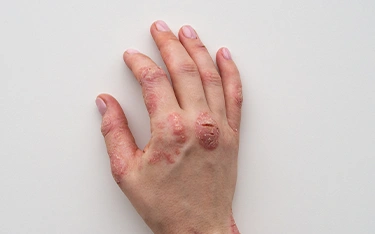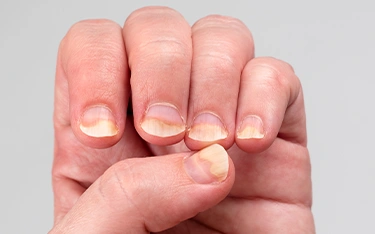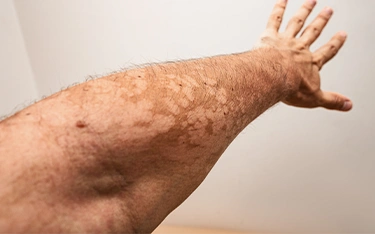Psoriasis is a chronic skin disorder that affects 2% of the world’s population. Among its various forms, one lesser-known but particularly uncomfortable variant is inverse psoriasis.
Unlike plaque psoriasis, which forms scaly, raised lesions on the elbows, knees, and scalp, inverse psoriasis affects skin folds such as the armpits, groin, under the breasts, or around the genitals and buttocks. However, it is essential to note that any psoriasis, such as inverse psoriasis, is not contagious, but rather a chronic immune-mediated condition that requires ongoing management.
The inflammation causes the keratinocytes to multiply at a faster rate. These cells move to the middle layer of the skin, known as the dermis, where they finally make their way to the epidermis, the outermost layer of the skin. These cells start breaking the barrier of the stratum corneum, and the skin thickens.
This activity forms the typical inverse psoriasis lesions. This induces hyperplasia (increased cell production) and increased vascularity, which tends to give redness. This leads to a cascade of inflammatory activity, which, in turn, leads to division of keratinocytes.
Inverse psoriasis is often misdiagnosed because it lacks the thick silvery scales typically associated with psoriasis. Understanding inverse psoriasis, its causes, and treatment strategies empowers patients to take charge of their skin health and quality of life.
What Causes Inverse Psoriasis?
Inverse psoriasis stems from an overactive immune system that mistakenly accelerates the skin cell life cycle. Instead of renewing every 28–30 days, skin cells multiply within a few days, leading to inflammation and visible patches. Several factors contribute to its onset and flares:
-
Immune Dysfunction
Inverse psoriasis, like other psoriasis types, is driven by an overactive immune system. Normally, immune cells defend the body against infections. In psoriasis, however, T-cells mistakenly attack healthy skin cells, triggering excessive inflammation. This speeds up skin cell turnover, causing red, shiny patches in sensitive folds.
-
Genetic Predisposition
Inverse psoriasis has a strong genetic component. If a parent, sibling, or close relative has psoriasis, the risk of developing it is significantly higher. Specific immune system gene variants are often inherited, predisposing individuals to psoriasis when exposed to environmental or lifestyle triggers.
Family history is a key risk factor. If only one parent is suffering from the condition, there is a 14%-28% chance that you will get it. When both parents have the condition, the chances of passing on the disorder are 40%-65%.
More Questions aboutPsoriasis Causes & Treatment
-
Environmental Triggers
Here are some environmental triggers that can cause inverse psoriasis:
- Heat and humidity worsen sweating and irritation.
- Friction from clothing or skin-to-skin contact aggravates folds.
- Certain soaps, detergents, or fragrances can irritate sensitive skin.
-
Obesity
Obesity increases the number of skin folds where inverse psoriasis commonly develops. Excess weight also raises systemic inflammation, worsening overall psoriasis severity.
Sweat and friction in these folds create an ideal environment for flare-ups to occur. Maintaining a healthy diet and engaging in regular exercise can help alleviate symptoms and prevent recurrences.
-
Candida or Fungal Infections
Yeast infections frequently occur in warm, moist skin folds and may intensify inverse psoriasis symptoms. Dermatologists often treat both conditions simultaneously.
-
Vitamin D Deficiency.
Vitamin D plays an essential role in skin health and immune regulation. Low vitamin D levels may disrupt immune balance, leading to increased inflammation and a higher risk of psoriasis flares.
-
Stress
Stress is a well-documented trigger for psoriasis, including inverse psoriasis. It increases cortisol levels, which fuel inflammation and weaken immune balance. Stressful events or chronic anxiety can lead to flare-ups.
-
Smoking
Smoking is strongly associated with inverse psoriasis development and flares. Chemicals in tobacco promote inflammation and impair skin healing.
Nicotine also affects immune function, making the body more prone to psoriasis triggers. Quitting smoking not only improves psoriasis outcomes but also reduces the risk for many other chronic health conditions.
-
Certain Medicines Like Beta-Blockers
Beta blockers are known to trigger or worsen psoriasis, including inverse psoriasis. These drugs, commonly prescribed for high blood pressure, heart disease, and anxiety, can interfere with immune system regulation and skin cell turnover.
Although not everyone experiences side effects, research shows that beta-blockers may provoke psoriasis flares or make existing symptoms harder to manage. If a patient with psoriasis requires beta blockers, dermatologists and physicians often closely monitor skin changes and may adjust treatment if symptoms worsen.
-
Consumption of Alcohol
Alcohol consumption can worsen inflammation in the body and weaken the immune system, both of which play key roles in psoriasis. Frequent or heavy drinking is linked with more severe flares and reduced treatment effectiveness. People with inverse psoriasis are advised to limit alcohol for better symptom management.
Dermatologist Insight
Many experts believe that inverse psoriasis is particularly challenging to treat. This is because it often appears in delicate areas, such as the groin, where standard treatments like strong corticosteroids may cause skin thinning. Management requires balancing effectiveness and safety.
Common Symptoms of Inverse Psoriasis
Recognizing the inverse psoriasis symptoms helps patients seek early medical help and avoid misdiagnosis with fungal infections or dermatitis. Unlike plaque psoriasis, there are no thick scales. Instead, the condition is characterized by:
- Red or Inflamed Patches: Shiny, smooth, and clearly demarcated.
- Location in Body Folds: Underarms, groin, beneath breasts, around buttocks, or inner thighs.
- Pain or Discomfort: Especially during movement when skin rubs together.
- Itching: Can be intense, leading to scratching and worsening irritation.
- Moist Appearance: Unlike dry plaques, these lesions often look wet due to sweat.
- Risk of Secondary Infections: Constant moisture increases the chances of bacterial or fungal overgrowth.
It is important to note that professional medical help is required to diagnose inverse psoriasis, as it is essential. Dermatologists use physical exams and sometimes skin biopsies to confirm psoriasis.
Inverse Psoriasis on the Scalp: Is It Possible?
Traditionally, inverse psoriasis affects flexural or intertriginous areas (folds). The scalp is typically associated with plaque psoriasis, which shows thick, scaly, flaky patches.
However, in some rare cases, inverse psoriasis scalp involvement may occur around the edges of folds near the neck, hairline, or behind the ears. These regions are prone to sweating and friction, mimicking the characteristics of inverse psoriasis.
It is important to differentiate:
- Scalp Psoriasis: Raised, scaly plaques with silvery-white flakes.
- Inverse Psoriasis: Smooth, shiny patches with redness but without scaling.
Expert Clarification:
Psoriasis subtypes can overlap, and mixed forms may appear. This means patients may exhibit features of both plaque and inverse psoriasis around the scalp folds or hairline. Proper diagnosis is crucial since treatments for scalp psoriasis (like coal tar shampoos) may irritate fold-affected areas, while inverse psoriasis requires gentler options.
Also Read:
How Dr Batra’s® helps with Homeopathy in Inverse Psoriasis?
Dr Batra’s® Homeopathy provides individualized, holistic treatment for inverse psoriasis, without intrusive medications or harsh chemicals. Our Homeopathic remedies work to restore immune system balance, reduce flare-ups, and facilitate natural healing.
We help manage symptoms and reduce flare-ups by working with the body’s natural healing capabilities and improving overall health and well-being.
Always consult professional Homeopaths to create the best treatment plan specific to you, to build long-lasting solutions, and to help manage your inverse psoriasis effectively.
Home Remedies for Inverse Psoriasis
While medical treatments are essential, home remedies for inverse psoriasis may provide comfort and reduce flare-ups. These natural measures support, but do not replace, prescribed therapies.
- Aloe Vera Gel: Soothes inflammation, cools skin, and supports healing.
- Oatmeal Baths: Colloidal oatmeal helps calm itching and irritation.
- Baking Soda Paste or Cool Compresses: Provide short-term itch relief.
- Loose, Breathable Clothing: Cotton fabrics reduce friction and sweating.
- Good Hygiene Practices: Gently cleanse and dry folds daily; avoid harsh soaps.
Disclaimer: These remedies help manage discomfort but do not cure inverse psoriasis. Always consult your dermatologist before adding natural remedies for inverse psoriasis to your routine.




